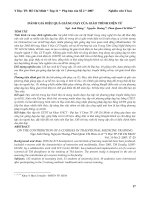Giáo trình ACNA - Chap05 potx
Bạn đang xem bản rút gọn của tài liệu. Xem và tải ngay bản đầy đủ của tài liệu tại đây (606.27 KB, 39 trang )
1
MAINTAINING THE
OPERATING
SYSTEM
Chapter 5
Chapter 5: MAINTAINING THE OPERATING SYSTEM 2
CHAPTER OVERVIEW
•
Understand the difference between service packs
and hot-fixes and the process of applying both
using Windows Update, Automatic Updates, and
group policies.
•
Use Microsoft Baseline Security Analyzer.
•
Install and configure a Microsoft Software Update
Services server.
•
Understand Per Server and Per Device or Per
User licensing.
•
Configure licenses using the Choose Licensing
Mode tool in Control Panel and using the
Licensing tool.
Chapter 5: MAINTAINING THE OPERATING SYSTEM 3
WINDOWS OPERATING SYSTEM
UPDATES
•
Update
•
A minor revision to a software product, usually
intended to address specific performance issues
rather than add new features
•
Upgrade
•
A major revision to a product that might include
new features as well as all of the existing patches
for the previous version of the product
Chapter 5: MAINTAINING THE OPERATING SYSTEM 4
SERVICE PACK
•
A collection of patches and other updates that are
tested and packaged as a single unit.
•
Service packs are cumulative: SP3 contains all
updates from SP1 and SP2.
•
Service pack releases are not on a schedule.
Chapter 5: MAINTAINING THE OPERATING SYSTEM 5
SERVICE PACK RELEASES
•
CD-ROM
•
Entire service pack on CD
•
Cost
•
Express download
•
Analyzes system and downloads only required
components
•
Requires Internet connection
•
Network download
•
Entire service pack in a single .exe file
•
For network administrator
Chapter 5: MAINTAINING THE OPERATING SYSTEM 6
HOTFIXES
•
Designed to address a specific issue
•
Downloadable as a single executable
•
Normally directly associated with a Knowledge
Base article
Chapter 5: MAINTAINING THE OPERATING SYSTEM 7
WHEN SHOULD YOU UPDATE?
Chapter 5: MAINTAINING THE OPERATING SYSTEM 8
WHEN SHOULD YOU UPDATE?
•
Remain aware of new update releases
•
Determine which computers need to be updated
•
Test update releases on multiple system
configurations
•
Deploy update releases on large fleets
•
Test and apply security patches
Chapter 5: MAINTAINING THE OPERATING SYSTEM 9
UNINSTALLING SERVICE PACKS
•
Requires considerable disk space
•
Service packs can be uninstalled through
Add/Remove Programs in Control Panel
•
Should be done only if the service pack
installation is causing new issues
•
Stored in folder $ntservicepackuninstall$
Chapter 5: MAINTAINING THE OPERATING SYSTEM 10
USING MICROSOFT BASELINE SECURITY
ANALYZER
Chapter 5: MAINTAINING THE OPERATING SYSTEM 11
USING WINDOWS UPDATE
Chapter 5: MAINTAINING THE OPERATING SYSTEM 12
USING AUTOMATIC UPDATES
•
Available in Windows Server 2003, Windows XP
(Service Pack 1), Windows 2000 (Service Pack 3).
•
Default is to automatically download updates and
prompt the user to install them.
•
Configured via the Automatic Updates tab in
System Properties. In Windows 2000, it is
configured via the Automatic Updates control
panel.
Chapter 5: MAINTAINING THE OPERATING SYSTEM 13
INSTALLING SERVICE PACKS MANUALLY
Chapter 5: MAINTAINING THE OPERATING SYSTEM 14
INSTALLING HOTFIXES MANUALLY
•
Hotfix filenames are formatted as:
•
OperatingSystem-KnowledgeBase#-Platform-
Language.exe
•
Example:
•
WindowsServer2003-KB823980-x86-ENU.exe
•
Backup folder $NtUninstallKB823980$
Chapter 5: MAINTAINING THE OPERATING SYSTEM 15
CHAINING HOTFIXES
•
Use Qchain.exe to install multiple hotfixes at a
single time.
•
All hot-fix includes Qchain.exe
•
Use /Z switch to prevent restarts.
•
Qchain.exe ensures that the system uses the
correct version of that file when the installation is
complete.
•
Can also use Update.exe /Z /U batch option
•
Update.exe /Z /U
•
WIndowsServer2003-KB123456-x86-ENU /Z /U
•
WIndowsServer2003-KB124686-x86-ENU /U
Chapter 5: MAINTAINING THE OPERATING SYSTEM 16
SLIPSTREAMING
•
Slipstreaming a service pack
•
Slipstreaming hotfixes
•
Example:
•
Update.exe /s:DistributionFolder
•
W2K3SP1.exe /s:DistributionFolder
Chapter 5: MAINTAINING THE OPERATING SYSTEM 17
USING GROUP POLICIES
Chapter 5: MAINTAINING THE OPERATING SYSTEM 18
USING MICROSOFT SOFTWARE UPDATE
SERVICES
•
Allows software updates to be downloaded once
for the entire organization
•
Provides administrative control over what updates
are applied to clients
•
Does not update clients
•
Reduces Internet usage
•
Not on installation CD – must be download
•
http://www.m icrosoft.co m
/windowsserversystems
/sus
/default.mspx.
Chapter 5: MAINTAINING THE OPERATING SYSTEM 19
DEPLOYING SUS
•
SUS components
•
Synchronize server
•
Intranet Windows update server
•
Install a SUS server
•
Synchronize SUS server with Windows updates
•
Approve updates
•
Configure automatic updates clients
Chapter 5: MAINTAINING THE OPERATING SYSTEM 20
INSTALLING SUS
Chapter 5: MAINTAINING THE OPERATING SYSTEM 21
SYNCHRONIZING SUS
Chapter 5: MAINTAINING THE OPERATING SYSTEM 22
APPROVING UPDATES
Chapter 5: MAINTAINING THE OPERATING SYSTEM 23
CONFIGURING AUTOMATIC UPDATES
Chapter 5: MAINTAINING THE OPERATING SYSTEM 24
SUS Configuration
•
SUS files
•
Patch files
•
Metafile specifying platform and language
•
Language settings for locally stored files
•
Update approval settings
•
Automatic update
•
Wait for approval
Chapter 5: MAINTAINING THE OPERATING SYSTEM 25
Configuring SUS Automatic Updates
•
Automatic update options
•
Notify For Download and Notify For Install
•
Auto Download and Notify For Install
•
Auto Download and Schedule The Install
•
Specify where clients obtain updates
•
Automatic update scheduling
•
Time 1 to 60 minutes
•
Next schedule if client is offline
•
No Auto-Restart for scheduled automatic updates









